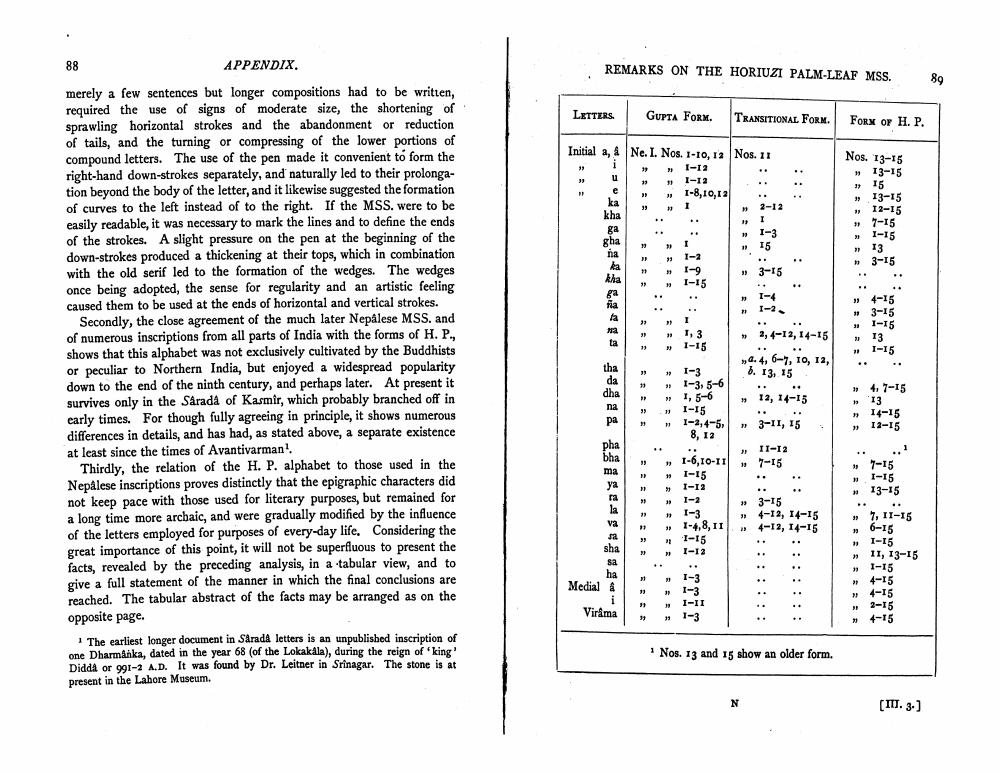________________
APPENDIX.
REMARKS ON THE HORIUZI PALM-LEAF MSS.
89
LETTERS.
GUPTA FORM.
TRANSITIONAL FORM.
FORM OF H. P.
Initial a, & Ne. I. Nos. 1-10, 13 Nos. 11
> > I-12 » 1-12 »
1-8,10,12 .. »
I
Nos. 13-15
» 13-15
» »
15 13-15
1-3
» » » »
12-15 7-15 1-15 13 3-15
15
»
3-15
DT::
»
1-4
» » » ·
4-15 3-15 1-15 13 1-15
merely a few sentences but longer compositions had to be written, required the use of signs of moderate size, the shortening of sprawling horizontal strokes and the abandonment or reduction of tails, and the turning or compressing of the lower portions of compound letters. The use of the pen made it convenient to form the right-hand down-strokes separately, and naturally led to their prolongation beyond the body of the letter, and it likewise suggested the formation of curves to the left instead of to the right. If the MSS. were to be easily readable, it was necessary to mark the lines and to define the ends of the strokes. A slight pressure on the pen at the beginning of the down-strokes produced a thickening at their tops, which in combination with the old serif led to the formation of the wedges. The wedges once being adopted, the sense for regularity and an artistic feeling caused them to be used at the ends of horizontal and vertical strokes.
Secondly, the close agreement of the much later Nepalese MSS. and of numerous inscriptions from all parts of India with the forms of H. P., shows that this alphabet was not exclusively cultivated by the Buddhists or peculiar to Northern India, but enjoyed a widespread popularity down to the end of the ninth century, and perhaps later. At present it survives only in the Sarada of Kasmir, which probably branched off in early times. For though fully agreeing in principle, it shows numerous differences in details, and has had, as stated above, a separate existence at least since the times of Avantivarman!
Thirdly, the relation of the H. P. alphabet to those used in the Nepalese inscriptions proves distinctly that the epigraphic characters did not keep pace with those used for literary purposes, but remained for a long time more arcbaic, and were gradually modified by the influence of the letters employed for purposes of every-day life. Considering the great importance of this point, it will not be superfluous to present the facts, revealed by the preceding analysis, in a tabular view, and to give a full statement of the manner in which the final conclusions are reached. The tabular abstract of the facts may be arranged as on the opposite page.
1 The earliest longer document in Sarada letters is an unpublished inscription of one Dbarmanka, dated in the year 68 (of the Lokakala), during the reign of 'king! Didda or 991-2 A.D. It was found by Dr. Leitner in Srinagar. The stone is at present in the Lahore Museum.
2, 4-12, 14-15 ,,. 4, 6-7, 10, 12,
6. 13, 15 ► 12, 14-15
3-11, 15
>>
1-3, 5-6 » 1, 5-6 » 11-15 - 1-2,4-5,
8, 12
4. 7-15 13 14-15 12-15
►
11-12
7-15
1-6,10-11 1-15 1-12
# 7-15 11-15 + 13-15
1-2
» » 4
3-15 4-12, 14-15 -12, 14-15
» »
1-4,8,11 I-15 1-12
»
7. II-15 6-15 I-15 11, 13-15 1-15 4-15 4-15 2-15 4-15
Medial &
Viráma
» # #
1-3 1-3 I-II 1-3
>>
» » » *
Nos. 13 and 15 show an older form.
(IV. 3.)




